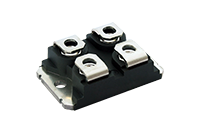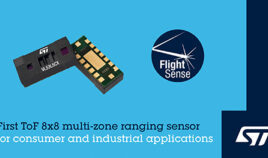Vishay Intertechnology has introduced a new fourth-generation 600 V EF Series fast-body diode MOSFET in the low-profile PowerPAK 10 x 12 package. Providing high efficiency and power density for telecom, industrial, and computing applications, the Vishay Siliconix n-channel SiHK045N60EF slashes on-resistance by 29% compared to previous-generation devices. It also delivers a 60% lower gate charge. This…
Vishay launches new Hyperfast and Ultrafast rectifiers
Vishay Intertechnology has introduced 15 new FRED Pt Gen 5 600 V and 1200 V Hyperfast and Ultrafast rectifiers in the compact SOT-227 package. Offering the best conduction and switching loss trade-off for devices in their class, the Vishay Semiconductors rectifiers are designed to increase the efficiency of high-frequency converters and of soft-switched or resonant designs.…
Using MicroPython SSD1306 driver to interface an OLED display with ESP8266 & ESP32
You’ve likely heard about SSD1306 or SSD1315 organic light-emitting diode (OLED) displays. These monochrome screens are typically in a similar price range as character displays, providing a more aesthetic appeal. More significantly, they provide a truly graphical interface for an embedded device. The OLED displays are available in ready-to-use breakout boards that can easily push…
STMicroelectronics’ new touchscreen controller for smartphones enables longer runtime
The FingerTip FTG2-SLP touchscreen controller from STMicroelectronics enables advanced features to support the latest active-matrix organic light-emitting diode (AMOLED) displays that promise more power-saving and extended runtime in smartphones. Low-temperature polycrystalline oxide (LTPO) AMOLED displays, and similar proprietary equivalents, dynamically control the display refresh rate according to usage. While refreshing more slowly with the less demanding…
How to display data from an ultrasonic distance-measurement sensor on an OLED
In Part 1 of this series, we learned how to interface an organic light-emitting diode (OLED) display, using analog voltage (a potentiometer), with Arduino. In Part 2, we covered how to present data from an analog sensor — specifically, a light-dependent resistor (LDR) and soil moisture sensor — on an OLED display. In Part 3,…
What is a diode?
What is a Diode? A Diode is the simplest two-terminal unilateral semiconductor device. It allows current to flow only in one direction and blocks the current that flows in the opposite direction. The two terminals of the diode are called as anode and cathode. The symbol of diode is as shown in the figure below. …
Toshiba launches TVS diode that protects IoT devices
Toshiba Electronic Devices & Storage Corporation has launched “DF2B6M4BSL,” an ultra-low capacitance TVS diode for high-frequency antennas. The diode protects semiconductors and other electronic components from static electricity and noise while suppressing signal deterioration. Electronic components in the high-frequency antennas used in radio communications, such as Wi-Fi, need to be protected by suppressing high harmonic distortion.…
STMicroelectronics launches multi-zone FlightSense, time-of-flight sensor
STMicroelectronics announced the first multi-zone FlightSense time-of-flight sensor to be offered for general-purpose applications, bringing sophisticated distance sensing to the full spectrum of consumer and industrial products. The VL53L5CX sensor provides up to 64 sensing zones with multi-target detection, distance measurement up to four meters in each zone, and a wide square-edged field of view with…
Infineon and Bosch launch ultra-low loss diode for light vehicle generators
Infineon Technologies and Robert Bosch GmbH are launching a new ultra-low-loss diode: the Active Rectifying Diode for light vehicle generators. It enables an increase in generator efficiency of up to eight percent compared to conventional power conversion methods and facilitates generators to qualify as eco-innovations as defined by the European Union. Deploying the new diode…
Multimeter Tutorial: How to Test a Diode
Step 1: Understanding Diode Fig. 1: Image of a Diode Diode has two terminals Anode (+) and Cathode (-). Terminals can be identified by the shaded portion at the end of the diode. Terminal near the shaded portion is Cathode (-) and other one is anode (+). Diode can be tested with the help of Diode…
Insight – How Diode Works
This component needs no introduction. One of the first semiconductor based engineering components, diodes are an indispensible necessity for any current modern gadget or circuit. They are the basic logic block – the most fundamental unit.These two terminal-ed nonlinear passive elements ideally conduct only one way and hence protect the circuit as well as the source from any damage. Diodes are widely used in rectifier circuits, limiters, communication circuits, multiplier circuits and signal clippers as well as clamper circuits. This Insight will give an in depth view of a diode’s physicality. Read more to find out about how a diode works through images of its internal and external parts such as epoxy layer, rubber coat, metallic shell, inner semiconductor traces etc.
Fixed voltage power supply using bridge rectifier
A regulated power supply is vital for any electronic appliance because the semiconductor devices used in them have precise current and voltage ratings. Any [[wysiwyg_imageupload::]]deviation from these rating can damage the devices. This circuit supplies a constant DC output derived from the AC mains supply. This project is an improvement over the power supply circuit mentioned earlier. The unregulated DC output is fixed to a constant voltage level by using a voltage regulator. This circuit uses a 7805 linear voltage regulator, capacitors and resistors along with a diode derived bridge rectifier. From providing a fixed voltage supply to making sure that output reaches undisturbed to the device, the diodes and capacitors manage high efficient signal conveyal.
Power failure alarm using diode and astable mode of 555 timer
Sometimes there is need of devices which should intimate us when power goes off, so that we could switch off our devices if they are battery [[wysiwyg_imageupload::]]operated or they are getting power from some other limited source [such as for computer using UPS(uninterrupted power supply)]. This project can solve our purpose and can intimate us if power supply fails. This circuit has a 555 timer at its heart and following components that aid its working:1N4148 Diodes Resistors in the range of Kilo and Mega Ohms. Capacitors at the range of Micro Farads and Nano Farads.A 9volt battery taking care of the power supply of the circuit.











